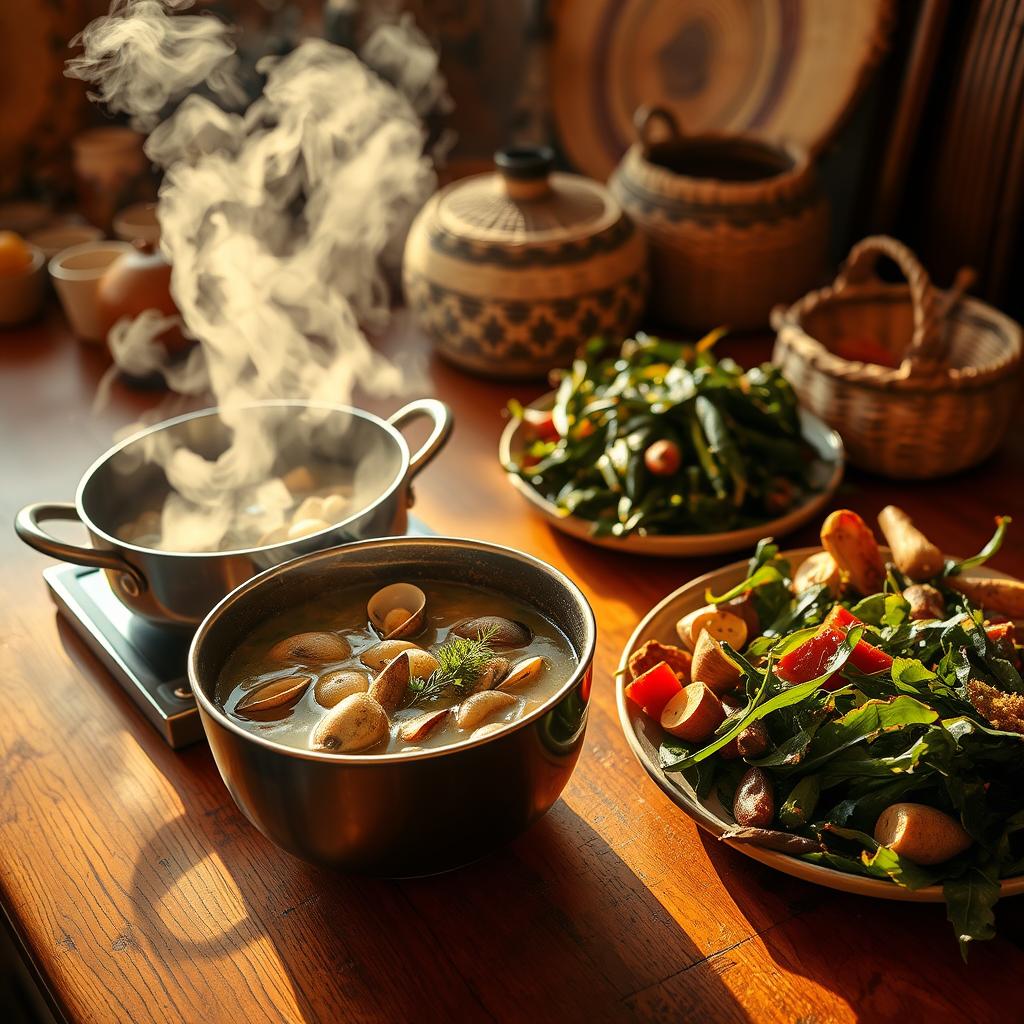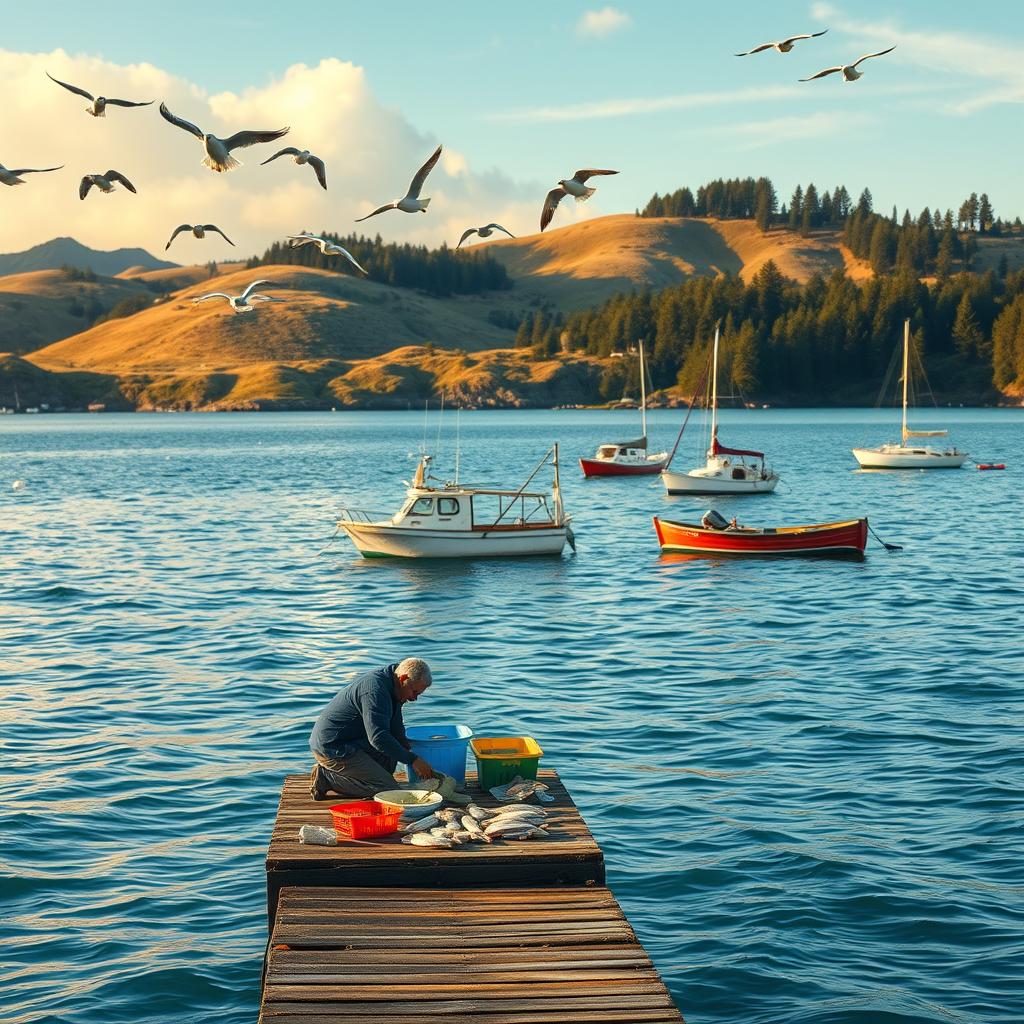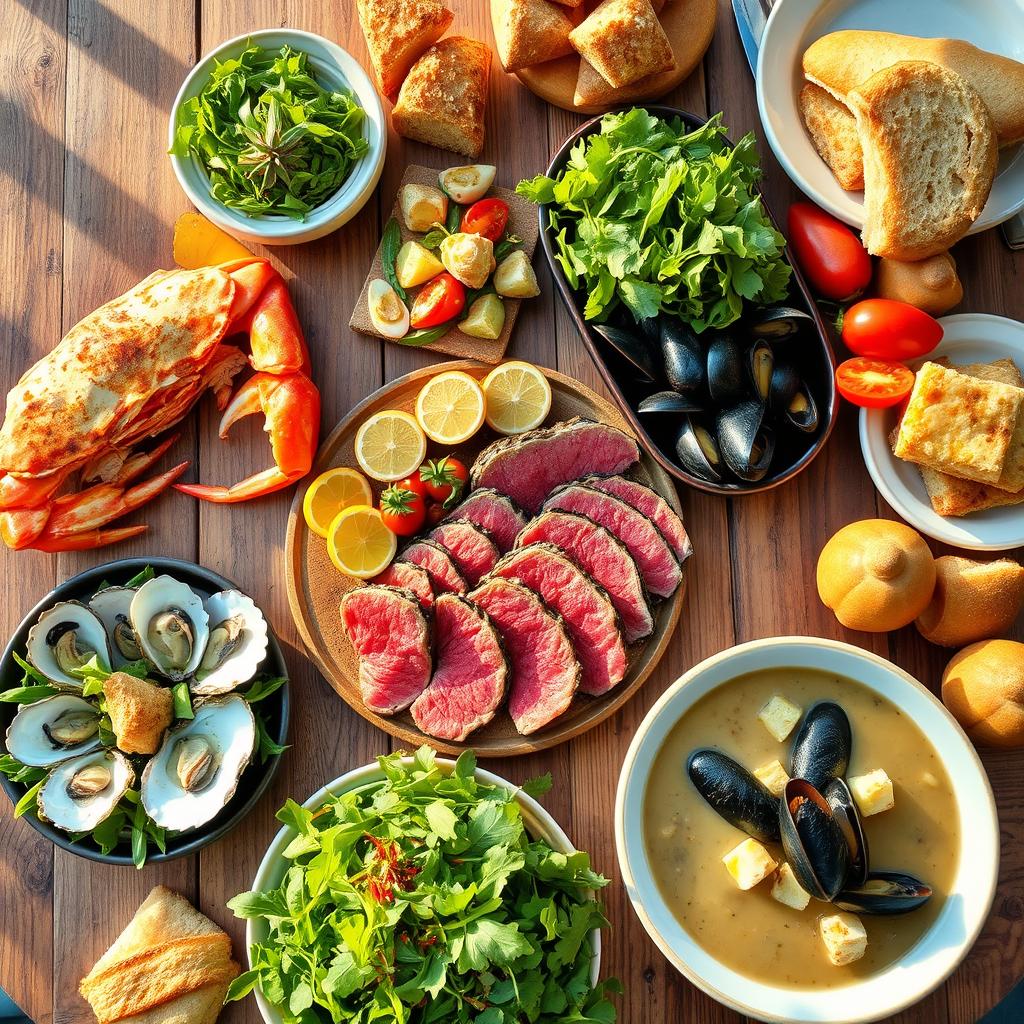Exploring Pacific Coast Cuisine: A Flavorful Journey
Get ready for a delicious journey through Pacific Coast cuisine! This guide will show you the flavors that make dining here special. You’ll see why food lovers love these shores.
The Pacific Coast has a rich food culture. It’s shaped by its diverse landscapes and cultures. You’ll find amazing wines in Paso Robles and award-winning cheeses in Oregon.
Did you know Paso Robles has over 300 wineries? Or that Oregon’s Rogue River Blue cheese won the 2019 World Cheese Awards?
Seafood lovers will love the region’s seafood. Dungeness crab, 6-7 inches, is a favorite from November to early September. Try salmon candy, a traditional dish made with molasses-based syrup.
Don’t miss the local produce. Oregon grows 33 million pounds of marionberries each year. These special blackberries, developed in 1948, are available year-round thanks to preservation.
Key Takeaways
- Paso Robles is a major wine region with over 300 wineries
- Oregon’s Rogue River Blue cheese won the 2019 World Cheese Awards
- Dungeness crab is a popular seafood choice, available most of the year
- Salmon candy is a unique Indigenous dish worth trying
- Marionberries are a local specialty fruit grown in Oregon
Understanding Pacific Coast Culinary Heritage
The Pacific Coast’s food history is filled with flavors and traditions. It spans from Ecuador’s shores to Fiji’s islands. This area’s cuisine is a mix of cultures and new ideas. It’s shaped by indigenous foods, making today’s dishes special.
Indigenous Influences on Coastal Cuisine
Native foods and cooking methods are key to Pacific Coast dishes. There are over 900 native foods in the area. The Periodic Table of Food Initiative works to show the variety of local foods.

Historical Development of Regional Food
The history of Pacific Coast food is rich. Limes were introduced 500 years ago, changing dishes like ceviche. In Peru, ceviche has a 3,000-year history, with the first recipe in 1866.
Cultural Significance of Pacific Coast Dishes
Pacific Coast foods celebrate culture. Peru honors ceviche on June 28th. The focus on local food systems supports food sovereignty and sustainability. There’s a push to use local foods for better health.
| Dish | Origin | Cultural Significance |
|---|---|---|
| Ceviche | Peru | National dish, celebrated annually |
| Encocado | Ecuador (Esmeraldas) | Showcases tropical ingredients |
| Bolón de Verde | Ecuador | Traditional breakfast food |
From Ecuador’s seafood to Peru’s ceviche, the cuisine keeps evolving. It celebrates cultural heritage and strengthens community ties.
Sustainable Harvesting Practices Along the Coast
The Pacific Coast is leading the way in sustainable food production. It balances nature with great taste. Here, 70% of the world’s fish catch comes from, making sure we have plenty of fresh seafood.
Coastal farming is also innovative. California, for example, is a top tomato producer. Pacific Coast Producers use family farms and drip irrigation. This saves water and increases tomato yields.

Energy use is another big focus. A grant helped with new evaporation tech. It saves a lot of energy and cuts down on carbon emissions.
In Fiji, they’ve created special fishing areas. These efforts help fish populations and protect marine life. They’re also fighting against illegal fishing.
The Pacific Coast is making a big difference. It’s showing us how to harvest food in a way that’s good for the planet. This ensures we have tasty, eco-friendly food for years to come.
Fresh Seafood Delicacies of the Pacific
The Pacific Coast is a treasure trove of seafood delights. It offers a bounty of ocean-fresh flavors. Let’s dive into the world of Pacific Coast seafood and explore some mouthwatering fresh fish recipes.
Local Fish Species and Preparation Methods
Pacific salmon is a top choice, prized for its omega-3 content. Halibut is another favorite, known for its sweet flavor. Pacific tuna is a healthy option, rich in protein and fatty acids.
Shellfish and Crustacean Varieties
Dungeness crab is a luxurious treat from the Pacific Northwest. Pacific oysters are a must-try, with their buttery texture. These delicacies are best enjoyed fresh, often served the same day they’re caught.
Traditional Seafood Recipes
Try regional specialties like Baja-style fish tacos in San Diego or shrimp and grits in Charleston. For a unique twist, visit Galveston for Southern and Tex-Mex seafood fusion dishes like blackened redfish.
- Seattle’s Pike Place Market: Fresh Dungeness crab and smoked salmon
- Newport, Oregon: Dungeness crab cakes
- Monterey, California: Local calamari dishes
Spring and summer are the best times for fresh seafood. With proper storage, you can enjoy these ocean treasures for up to 24 hours after purchase. Dive into the flavors of the Pacific Coast and create your own seafood masterpieces at home!
Common Foods in the Pacific Coast
The Pacific Coast is known for its rich flavors. It has dishes from Mexico to Colombia, all showing off local tastes and cooking styles. You’ll find many delicious foods that highlight the area’s unique ingredients and methods.
In Mexico’s Pacific Coast, seafood is a big deal. You’ll find octopus, swordfish, tuna, and black sea bass. Try the ceviche, a fresh seafood salad with citrus juices.
Central Mexico is all about pork, like carnitas. Puebla is known for mole poblano, a sauce with chocolate and chili peppers. In Mexico City, you’ll love barbacoa and chiles rellenos.
Colombian coastal food has its own taste. Arroz con coco, a coconut rice with fried fish, is a favorite on the Caribbean coast. The Pacific coast has sancocho de pescado, a fish soup with coconut milk and spices.
| Region | Popular Dish | Key Ingredients |
|---|---|---|
| North Pacific Mexico | Ceviche | Seafood, citrus juice, onions |
| Central Mexico | Mole Poblano | Chocolate, chili peppers, spices |
| Colombian Caribbean Coast | Arroz con Coco | Rice, coconut milk, fried fish |
| Colombian Pacific Coast | Sancocho de Pescado | Fish, coconut milk, yucca, plantains |
These dishes give you a taste of the Pacific Coast’s diverse food scene. Whether you want seafood, stews, or special flavors, there’s something for everyone here.
Seasonal Fruits and Vegetables
The Pacific Coast is a treasure trove of seasonal fruit and vegetables. From vibrant berries to exotic tropical fruits, this region’s diverse climate nurtures an incredible variety of produce. Let’s explore the bountiful harvest that graces tables along the coast throughout the year.
Native Berries and Their Uses
Pacific Coast produce is renowned for its native berries. You’ll find tart huckleberries and sweet marionberries flourishing in local gardens. These berries are packed with nutrients and flavor. A cup of raw berries can provide up to 20% of your daily vitamin C requirement. Locals use these fruits in jams, pies, and even savory dishes.
Tropical Fruit Varieties
Surprisingly, the Pacific Coast climate supports various tropical fruits. You can enjoy locally grown passion fruit, guavas, and kiwis. These fruits thrive in the region’s unique microclimates. Tropical fruits are not just delicious; they’re nutritional powerhouses. For instance, one kiwi fruit contains more vitamin C than an orange.
Local Vegetable Gardens
Seasonal fruit and vegetables are the heart of Pacific Coast cuisine. You’ll find everything from artichokes to zucchini at farmers’ markets all year. Broccoli, for example, is packed with vitamin C, giving you 135% of your daily needs.
Eating seasonally means you get the most nutritious and tasty produce. It’s a win-win for your health and taste buds.
| Season | Fruits | Vegetables |
|---|---|---|
| Spring | Strawberries, Cherries | Asparagus, Peas |
| Summer | Peaches, Blackberries | Tomatoes, Corn |
| Fall | Apples, Pears | Pumpkins, Brussels Sprouts |
| Winter | Citrus, Persimmons | Kale, Winter Squash |
Choosing Pacific Coast produce is good for your taste buds and the planet. It’s also often cheaper and more nutritious than out-of-season options. So, next time you shop, pick local and seasonal for the best flavors and health benefits.
Traditional Rice and Bean Dishes
Rice and beans are staples in Pacific Coast cuisine. They show the area’s rich culture and varied tastes.
Gallo pinto, Costa Rica’s national dish, mixes rice and black beans with spices and veggies. It’s often eaten for breakfast with eggs and cheese. For lunch, casado is a must-try, filled with rice, beans, plantains, salad, and your choice of meat.
Seafood is a big deal in rice dishes along the coast. Arroz con camarones combines rice with shrimp and veggies. Ceviche, on the other hand, features fresh fish marinated in citrus.
Bean recipes differ along the coast, each with its own twist. Sopa negra, a black bean soup, goes well with white rice. In the Caribbean, coconut milk makes rice and beans creamy and flavorful.
| Dish | Main Ingredients | Typical Serving |
|---|---|---|
| Gallo Pinto | Rice, black beans, spices | Breakfast |
| Casado | Rice, beans, plantains, protein | Lunch |
| Arroz con Camarones | Rice, shrimp, vegetables | Dinner |
| Sopa Negra | Black beans, rice | Any meal |
These rice and bean dishes from the Pacific Coast offer a taste of the area’s culinary traditions. Whether you’re in the mood for a hearty breakfast or a light seafood dinner, there’s something for everyone.
Pacific Coast Street Food Culture
The Pacific Coast has a lively street food scene that will excite your taste buds. You’ll find everything from bustling food markets to unique food stands. Each place offers a variety of flavors that highlight the region’s diverse cuisine.
Popular Food Stands and Markets
Food markets along the Pacific Coast are a treat for the senses. Chile’s coastline stretches over 4,300 kilometers, with each area offering its own special dishes. Arica and Iquique in the north are known for their seafood, especially ceviche.
In Panama City, the Mercado de Mariscos is a must-visit. Here, you can try different ceviche made from fresh fish, shrimp, or octopus.
Local Snacks and Quick Bites
Street food on the Pacific Coast is both tasty and affordable. In Chile, you can get empanadas or completos (Chilean hot dogs) for about $2 each. Sopaipillas, deep-fried pastries with pebre sauce, are also a favorite snack.
In Panama, street food costs between $1 to $3 per item. Try carimañolas or patacones for a local flavor.
The best time to enjoy coastal street food is during lunch (12-2pm) when vendors are busiest. For breakfast, look for traditional items like carimañolas. In the evening, indulge in churros or raspados for dessert.
Whether you’re in Chile’s wine country or Panama’s Afro-Caribbean spot in Bocas del Toro, the Pacific Coast’s street food is a culinary adventure for all.
Coastal Breakfast Traditions
Wake up to the tantalizing aromas of Pacific Coast breakfast traditions! The morning meal culture along the coast celebrates fresh, local ingredients. It also honors diverse culinary influences. From San Diego to San Francisco, you’ll find a rich tapestry of flavors.
Pacific Coast breakfast often features seafood, a nod to the area’s fishing roots. Dungeness crab benedicts are a popular choice, showcasing the ocean’s bounty. For a lighter start, try an acai bowl topped with California-grown fruits – a perfect blend of health and indulgence.
Sourdough pancakes are a must-try, paying homage to San Francisco’s famous Boudin Bakery. These fluffy delights pair wonderfully with locally-produced avocados, a staple in many coastal breakfast dishes.
- California burrito: A hearty breakfast option with carne asada, cheese, and fries
- Garlic-infused dishes: Inspired by Gilroy’s famous garlic ice cream
- Fresh fruit platters: Showcasing California’s abundant produce
Experience these morning meal traditions at cozy diners or trendy cafes dotting the coastline. Whether you prefer a robust feast or a light, nutritious start, Pacific Coast breakfast options cater to all tastes. They reflect the region’s diverse cultural influences and farm-fresh ingredients.
Essential Cooking Ingredients
The Pacific Coast is known for its unique cooking ingredients. These give its dishes a special taste. From fresh herbs to special spice mixes, these are key to coastal cooking.
Local Spices and Seasonings
Pacific Coast spices are full of flavor. Cilantro adds a fresh, citrusy taste to many dishes. Dill brings a light tang.
Old Bay seasoning, a mix of herbs and spices, is great for seafood. Kelp and other seaweeds add a unique umami flavor. They connect old traditions with new cooking ways.
Traditional Cooking Oils
Many Pacific Coast dishes start with special cooking oils. California’s olive groves make rich, tasty olive oil. It’s perfect for dressings and sautéing.
Nut oils from local orchards add depth to both savory and sweet dishes. These oils not only taste great but also share the region’s agricultural richness.
Adding these Pacific Coast spices and ingredients to your kitchen brings coastal flavors home. Try them out to make your own coastal dishes. It’s a great way to spice up your cooking.
| Ingredient | Origin | Common Use |
|---|---|---|
| Cilantro | Coastal regions | Salsas, marinades |
| Old Bay seasoning | Maryland | Seafood dishes |
| Olive oil | California | Cooking, dressings |
| Kelp | Pacific Ocean | Soups, seasonings |
Popular Restaurant Dishes
Pacific Coast restaurants are a feast for the senses. They offer a wide range of famous coastal meals. From San Francisco to Seattle, every dish is a journey of flavors.
In Southern California, fish tacos are a big hit. They mix Mexican flavors with local tastes. In San Francisco, cioppino is a seafood stew that celebrates the city’s fishing roots.
Seattle is known for its cedar-plank salmon. This method gives the fish a smoky taste that’s perfect with fresh seafood.
| Restaurant | Signature Dish | Price |
|---|---|---|
| Harbor House Inn | Five-course lunch | $150 |
| Ledford House | Three-course “bistro special” | $35 |
| Fishetarian Fish Market | Award-winning clam chowder | Varies |
For a memorable meal, try the Harbor House Inn in Elk, California. It offers a five-course lunch for $150. It’s a showcase of local ingredients and creative cooking.
Pacific Coast restaurants have something for everyone. Whether you love seafood, farm-to-table dishes, or new flavors, there’s a place for you. So, get ready to explore the flavors of this stunning coastline!
Fusion Cuisine Influences
Pacific Coast fusion food is changing the way we eat. Chefs mix traditional dishes with flavors from around the world. This creates new and exciting tastes. You’ll find dishes that show off the region’s many cultural influences.
Modern Interpretations of Classic Dishes
California’s fresh produce inspires chefs to update old recipes. Avocados, a favorite in California, are a key ingredient in the California roll. This sushi dish is now a symbol of fusion cuisine.
Local seafood like Dungeness crab and Chinook salmon get paired with new flavors. This gives old seafood dishes a fresh twist.
International Culinary Impact
The influence of international cuisine is clear in Pacific Coast food. Mexican fast food, known as taquería-style, is loved across California. The Mission burrito is a prime example of fusion food.
The region’s barbecue scene is a mix of styles from Arizona, New Mexico, Texas, and Oklahoma. This creates a unique California taste.
In the Pacific Northwest, fusion takes on new forms. Food carts and trucks offer dishes like bulgogi burritos and Korean tacos. Seattle’s food scene has its own teriyaki style and the Seattle Dog, topped with cream cheese.
These creative dishes show the region’s love for trying new things. They also highlight its rich cultural mix.
Preservation and Cooking Techniques
The Pacific Coast is known for its rich food preservation and cooking traditions. These methods have been passed down for generations. They help communities enjoy their harvests all year.
For centuries, people have preserved food by smoking salmon, pickling veggies, and canning fruits. Today, we also use vacuum-sealing and flash-freezing to keep seafood fresh. Indigenous cultures have cured meats and fish for years, making sure they can enjoy seasonal catches all year.
Pacific cooking is full of flavor and variety. Grilling on cedar planks gives fish a special taste. Clambakes on the beach are a fun way to cook with friends. Seafood cooks fast because it’s lean, so it’s important to cook it right.
- Grilling: 3-5 minutes per side
- Steaming: Under 10 minutes
- Pan-searing: 2-3 minutes per side
- Baking: 12-15 minutes at 375°F
To cook fish well, aim for an internal temperature of 145°F. Fresh seafood should have bright eyes and shiny skin. It should not smell strongly of fish. By learning these preservation and cooking methods, you can enjoy coastal flavors all year!
Beverage Culture and Traditions
Pacific Coast drinks blend flavors and traditions. From Oregon’s misty shores to Chile’s sunny beaches, there’s a wide variety. They reflect the region’s culture and natural beauty.
Local Coffee and Tea Practices
Coffee culture thrives along the Pacific Coast. In Oregon, don’t miss the Florence Rhododendron Festival. It’s a long flower festival on the West Coast.
In Chile, coffee is enjoyed in traditional cafes. Peru’s coffee scene is also vibrant, with Lima’s cafes offering rich brews from the highlands.
Traditional Refreshments
Pacific Coast drinks include more than coffee and tea. In Chile, try “mote con huesillo,” a sweet drink made from wheat and dried peaches. Peru’s Pisco Sour is a must-try.
At the Mendocino Whale Festival, enjoy local wines and learn about whale conservation. Oregon’s Yachats Mushroom Festival offers mushroom drinks, showing the region’s foraging traditions.
Trying local coffee or a traditional cocktail is a flavorful journey. Pacific Coast drinks connect you to coastal culture and traditions.


